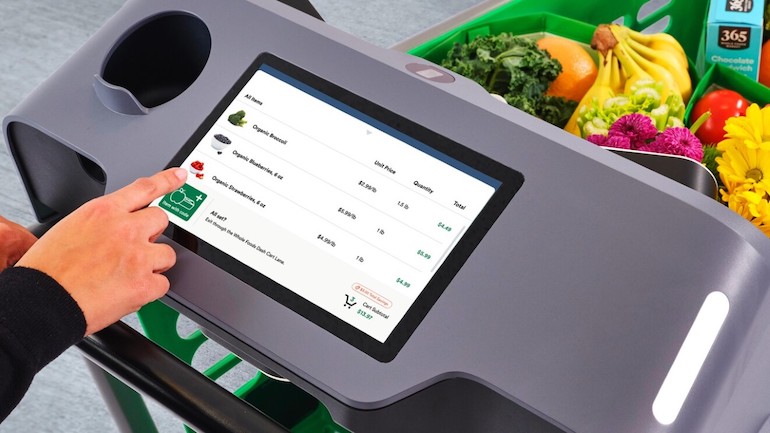Amazon extended its string of strong physical-store sales growth in the fiscal 2022 second quarter, recording its fifth straight quarter of double-digit gains.
For the quarter ended June 30, overall net sales came in at $121.23 billion, up 7.2% from $113.08 billion a year earlier, Amazon reported yesterday after the market close. Excluding a $3.6 billion unfavorable impact from foreign exchange (FX) rate fluctuation, net sales rose 10% year over year, the Seattle-based company said.
Online sales declined 4.3% to $50.86 billion (flat excluding FX) for the second quarter from $53.16 billion a year ago. Sequentially, online sales dipped 0.5% from the first to second quarters.
Amazon’s physical store sales, which include Whole Foods Market, surged 12.5% (13% excluding FX) to $4.72 billion in Q2 from just under $4.2 billion in the fiscal 2021 quarter. grew 17.1% (about 16% excluding FX) to $4.59 billion in the first quarter from $3.92 billion in the prior-year period. That followed year-over-year gains of 17.1% in the 2022 first quarter, 16.6% in the 2021 fourth quarter, 13% in the third quarter and 11% in the second quarter, which came after a 15.5% decrease in the 2021 first quarter.
On a sequential basis, sales at brick-and-mortar stores edged up 2.8% for the 2022 second quarter after decreasing nearly 2.1% in the first quarter, which followed three quarterly increases.

Amazon has introduced a new version of the Amazon Dash Cart smart shopping cart that brings extra functionality and will be introduced at Whole Foods Market.
Physical-store sales at Amazon come mainly from the Whole Foods unit and exclude online orders made via the company’s brick-and-mortar brands, such as Prime delivery and pickup through Whole Foods stores. Currently, Amazon’s U.S. physical stores include 517 Whole Foods Markets, 39 Amazon Fresh grocery stores and 27 Amazon Go convenience stores.
For the 2022 first half, Amazon’s total net sales were $237.68 billion, up 7.3% from $221.6 billion in the first six months of 2021. Online sales were down 3.8% to $101.98 billion from $106.06 billion. First-half sales for physical stores jumped 14.7% to $9.31 billion from $8.12 billion in the year-ago span.
On the brick-and-mortar front during Q2, Amazon noted that it continued to expand its grocery store footprint with the opening of 12 Amazon Fresh stores in the United States and the United Kingdom. In late June, Amazon also announced a 20% year-round discount at Amazon Fresh stores for Prime members and introduced Store Analytics, a marketing measurement service that provides CPG brands with data-driven insights about their products, promotions and ad campaigns in Amazon Fresh and Amazon Go stores.
In late April, Amazon announced that it’s is working to enable virtually all households participating in the Supplemental Nutrition Assistance Program (SNAP) to use electronic benefits transfer (EBT) to pay for online grocery orders. The company said its e-grocery services currently reach SNAP recipients in 48 states and the District of Columbia, giving over 99% of SNAP households the ability to use their benefits online via Amazon.com, Amazon Fresh and Whole Foods.
And earlier this month, Amazon introduced the next-generation Amazon Dash Cart, which brings added functionality for Amazon Fresh shoppers and is slated to roll out to its first Whole Foods Market store.
“Despite continued inflationary pressures in fuel, energy, and transportation costs, we’re making progress on the more controllable costs we referenced last quarter, particularly improving the productivity of our fulfillment network,” Amazon CEO Andy Jassy said in a statement Thursday on Q2 results. “We’re also seeing revenue accelerate as we continue to make Prime even better for members, both investing in faster shipping speeds and adding unique benefits such as free delivery from Grubhub for a year, exclusive access to NFL Thursday Night Football games starting Sept. 15, and releasing the highly anticipated series ‘The Lord of the Rings: The Rings of Power’ on Sept. 2.”
At the bottom line, Amazon reported 2022 second-quarter net loss of $2.03 billion, or 20 cents per diluted share, compared with net earnings of $7.78 billion, or $76 cents per diluted share, a year earlier. The company noted that the 2022 quarter result reflects a pretax valuation loss of $3.9 billion included in non-operating expense from its common stock investment in Rivian Automotive. Analysts, on average, had forecast adjusted earnings per share of 13 cents, according to Refinitiv.


